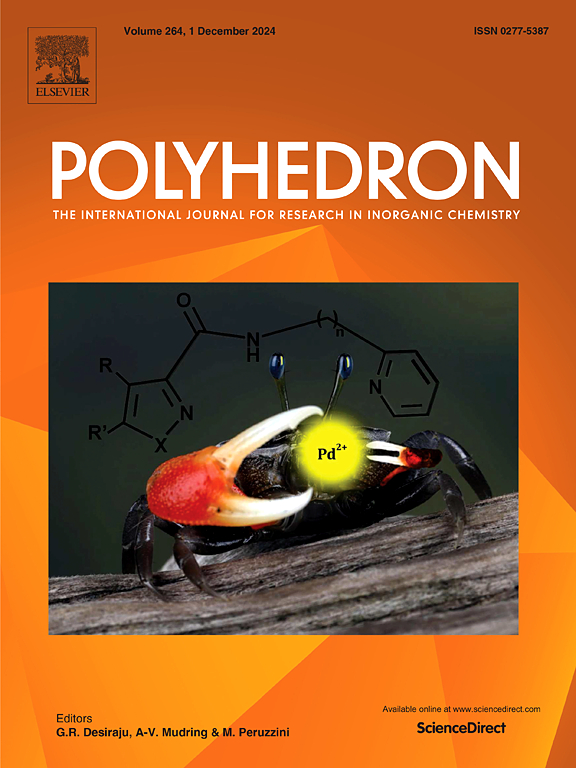两种Cu(II)配合物的合成、结构、DNA结合及抗癌活性
IF 2.6
3区 化学
Q2 CHEMISTRY, INORGANIC & NUCLEAR
引用次数: 0
摘要
本文采用水热法合成了两个新的铜基配合物(配合物1 = Cu2(dcbpy)2·(H2O)2]·2H2O和配合物2 = Cu5(dpa)2·(H2O)6]·12.4H2O)。采用x射线单晶衍射法确定配合物的结构,并用PXRD、红外、热重分析、XPS等方法对配合物进行了表征。通过紫外光谱和荧光光谱研究了配合物对DNA的结合能力,两种配合物的结合常数分别为0.0584和0.0311 M−1,具有良好的结合能力。通过凝胶电泳评估了复合物切割DNA的能力,发现两者都有效地切割DNA。此外,流式细胞术、倒置显微镜和形态学研究也证明了这些复合物可以诱导细胞凋亡。分子模拟对接计算表明,这两个配合物的键能分别为−7.71和−5.25 kcal/mol。在所有实验中,复合物1表现出更好的性能。在所有的实验中,复合物1表现出更好的性能。这为开发新型铜基复合抗癌药物提供了潜在的候选材料。本文章由计算机程序翻译,如有差异,请以英文原文为准。
Synthesis, structure, DNA binding and anticancer activities of two Cu(II) complexes
In this work, two new Cu-based complexes (Complex 1 = Cu2(dcbpy)2·(H2O)2]·2H2O and Complex 2 = Cu5(dpa)2·(H2O)6]·12.4H2O) were synthesized by hydrothermal method. X-ray single crystal diffraction was used to determine the structure of complexes and characterized them by PXRD, infrared, thermogravimetric analysis, XPS, etc. The binding ability of the complexes to DNA was studied by UV and fluorescence spectroscopy, and both complexes showed good binding ability with binding constants of 0.0584 and 0.0311 M−1 respectively. The capability of the complexes to cleave DNA was assessed through gel electrophoresis, and both were found to be effective in cutting DNA. In addition, flow cytometry, inverted microscopy and morphological studies have also proved that the complexes can induce apoptosis. Molecular simulation docking calculations revealed that the bonding energies of the two complexes were −7.71 and −5.25 kcal/mol respectively. In all experiments, complex 1 exhibited better performance. In all experiments, complex 1 showed better performance. It provides potential candidate materials for the development of novel Cu-based complex anticancer drugs.
求助全文
通过发布文献求助,成功后即可免费获取论文全文。
去求助
来源期刊

Polyhedron
化学-晶体学
CiteScore
4.90
自引率
7.70%
发文量
515
审稿时长
2 months
期刊介绍:
Polyhedron publishes original, fundamental, experimental and theoretical work of the highest quality in all the major areas of inorganic chemistry. This includes synthetic chemistry, coordination chemistry, organometallic chemistry, bioinorganic chemistry, and solid-state and materials chemistry.
Papers should be significant pieces of work, and all new compounds must be appropriately characterized. The inclusion of single-crystal X-ray structural data is strongly encouraged, but papers reporting only the X-ray structure determination of a single compound will usually not be considered. Papers on solid-state or materials chemistry will be expected to have a significant molecular chemistry component (such as the synthesis and characterization of the molecular precursors and/or a systematic study of the use of different precursors or reaction conditions) or demonstrate a cutting-edge application (for example inorganic materials for energy applications). Papers dealing only with stability constants are not considered.
 求助内容:
求助内容: 应助结果提醒方式:
应助结果提醒方式:


